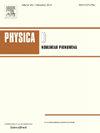Mathematical modeling on peristaltic flow of a Prandtl fluid with effects of slip conditions and inclined magnetic field
IF 2.9
3区 数学
Q1 MATHEMATICS, APPLIED
引用次数: 0
Abstract
The manuscript provides a description of a theoretical analysis of a non-Newtonian Prandtl fluid that is subject to peristaltic flow via an inclined asymmetric channel. We explore the effect of an inclined magnetic field on the peristaltic flow. This is relevant for applications of fluid flow in narrow, inclined (tilted) tubes that are similar to blood vessels or to the digestive system. The model also includes thermodynamic aspects such as heat diffusion (the Soret effect) and viscous dissipation as a result of wall–fluid slip conditions, which help optimize medical devices like lab-on-a-chip systems and dialysis machines. In this study, the concentration of a generic chemical, temperature and fluid velocity are taken into account through mass, heat and momentum balances, respectively. The solution is approximated by the use of numerical techniques that are suitable for cases with long wavelengths (low frequency) and low Reynold’s numbers. The study also discusses the effects of trapping phenomena, which is a crucial issue from a clinical point of view. The developed insights can be used to improve the understanding of physiological flows in the gastrointestinal tract and in blood vessels. By understanding how the fluid moves and how particles are trapped, these insights help to design better medical pumps and artificial organs. A graphical visualization is provided for the fluid velocity profile, temperature distribution and concentration of a generic chemical. Furthermore, a validation of our numerical results has been provided by means of a comparison with a closed-form solution from a benchmark problem. The Prandtl fluid parameters and have an opposite impact on the axial velocity. Furthermore, an increase in the Schmidt number, , gives a decrease of the concentration of the dissolved chemical. The model predicts that channel inclination has no significant effect on the concentration profile. Furthermore, the model indicates that the Prandtl fluid parameters and hardly impact the size of the bolus trapped between the streamlines.
考虑滑移条件和倾斜磁场影响的普朗特流体蠕动流动的数学建模
手稿提供了一个非牛顿普朗特流体的理论分析的描述,这是受蠕动流动通过一个倾斜的不对称通道。我们探讨了倾斜磁场对蠕动流动的影响。这与流体在类似血管或消化系统的狭窄、倾斜(倾斜)管中流动的应用有关。该模型还包括热力学方面,如热扩散(Soret效应)和由于壁面流体滑移条件导致的粘性耗散,这有助于优化芯片实验室系统和透析机等医疗设备。在本研究中,通过质量平衡、热和动量平衡分别考虑了一般化学物质的浓度、温度和流体速度。通过使用适合于长波长(低频)和低雷诺数的情况的数值技术来近似求解。本研究还讨论了诱捕现象的影响,这从临床角度来看是一个关键问题。发展的见解可以用来提高对胃肠道和血管中的生理流动的理解。通过了解流体如何运动以及粒子如何被捕获,这些见解有助于设计更好的医疗泵和人造器官。提供了一种通用化学品的流体速度分布、温度分布和浓度的图形可视化。此外,通过与一个基准问题的封闭解的比较,验证了我们的数值结果。普朗特流体参数α和β对轴向速度的影响相反。此外,施密特数Sc的增加使溶解的化学物质的浓度降低。该模型预测,通道倾角对浓度分布无显著影响。此外,该模型还表明,普朗特流体参数α和β对流线之间的颗粒大小几乎没有影响。
本文章由计算机程序翻译,如有差异,请以英文原文为准。
求助全文
约1分钟内获得全文
求助全文
来源期刊

Physica D: Nonlinear Phenomena
物理-物理:数学物理
CiteScore
7.30
自引率
7.50%
发文量
213
审稿时长
65 days
期刊介绍:
Physica D (Nonlinear Phenomena) publishes research and review articles reporting on experimental and theoretical works, techniques and ideas that advance the understanding of nonlinear phenomena. Topics encompass wave motion in physical, chemical and biological systems; physical or biological phenomena governed by nonlinear field equations, including hydrodynamics and turbulence; pattern formation and cooperative phenomena; instability, bifurcations, chaos, and space-time disorder; integrable/Hamiltonian systems; asymptotic analysis and, more generally, mathematical methods for nonlinear systems.
 求助内容:
求助内容: 应助结果提醒方式:
应助结果提醒方式:


